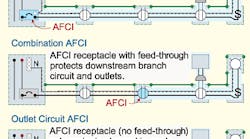Although new to the NEC, AFCIs are important for protecting against arc faults.
Unsafe arc faults can occur as series or parallel arcs. A series arc can occur when the conductor in series with the load breaks. The series configuration means the arc current cannot be greater than the load current the conductor serves. Typically, series arcs don't develop sufficient thermal energy to create a fire.
More dangerous is the parallel arc fault, which can occur as a short circuit or a ground fault. A short circuit arc decreases the dielectric strength of insulation separating the conductors, allowing a high-impedance, low-current arc fault to develop that carbonizes the conductor's insulation, further decreasing the dielectric of the insulation separating the conductors. The result is increased current, exponentially increased thermal energy, and the likelihood of a fire. The current flow in a short circuit, parallel arc fault is limited by the system impedance and the impedance of the arc fault itself.
A ground fault parallel arc fault can occur only when a ground path is present. This type of arc fault can be cleared by a GFCI or an AFCI. The RMS current value for parallel arc faults will be considerably less than that of a solid, bolted-type fault. Therefore, a typical 15A breaker might not clear this fault before a fire ignites.
UL 1699 contains the requirements for listing AFCI devices. Each type of AFCI protects different aspects of the branch circuit and extension wiring. However, only the branch/feeder AFCI meets NEC requirements. AFCIs are not designed to prevent fires caused by series arcing at loose connections. Let's look at examples of AFCIs.
Branch/feeder AFCI.
This device is installed at the origin of a branch circuit or feeder like a panelboard. It provides parallel arc-fault protection for branch circuit wiring, cord sets, and power supply cords. It's not UL-Listed to provide series-type arc-fault protection.
Combination AFCI.
This device, which is typically a receptacle, provides parallel and series arc-fault protection for branch circuit wiring, cord sets and power supply cords downstream from the device. It doesn't, however, provide parallel arc-fault protection upstream.
Outlet circuit AFCI
This device is installed at a branch circuit outlet. It provides parallel and series arc-fault protection for the cord sets and power-supply cords plugged into the outlet. However, it doesn't provide arc-fault protection on feed-through branch circuit conductors, nor does it provide parallel arc-fault protection upstream from the device.
Although AFCIs have their uses, it's important to note that these protection devices are not designed to prevent fires caused by series arcing at loose connections in devices like switches or receptacles.





